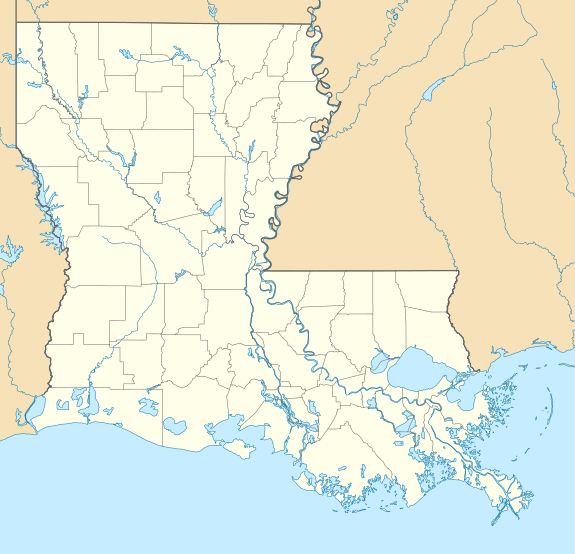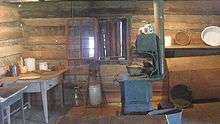Germantown Colony and Museum
The Germantown Colony and Museum is an historical preservation project north of Minden in Webster Parish in northwestern Louisiana, USA. It was among three sites in Louisiana founded by former members of the Utopian Movement called the Harmony Society in the early 19th century.[2]
Germantown Colony Museum | |
 Countess Leon's House at Germantown Colony | |
  | |
| Location | Off U.S. 79, Minden, Louisiana, USA |
|---|---|
| Coordinates | 32°42′0″N 93°13′50″W |
| Built | 1835 |
| NRHP reference No. | 79001100[1] |
| Added to NRHP | March 12, 1979 |
Historical background
The original colonists came from Germany, having first settled in Harmony, Pennsylvania, in 1803, then in New Harmony, Indiana in 1814, and finally in 1825 in Economy (now Ambridge, Pennsylvania).[2]
About 250 former members of the Harmony Society, many of whom left Economy, Pennsylvania, during 1832, decided to leave because of disagreements over the society's custom of celibacy. They followed a visionary named Bernhard Müller, who called himself "Count de Leon". The Count called upon all the heads of Europe to relinquish their crowns in a "new world to come."[3]
The New Philadelphian Congregation, established by the New Philadelphia Society, planted its first colony in 1832 at Phillipsburg (now Monaca), Pennsylvania. Perhaps because of ongoing litigation, and other financial problems, Müller's group decided to sell their communal land in Pennsylvania in 1833. Some community members stayed, while others followed Müller and his family down the Ohio River on a flatboat. Soon they started again at Grand Ecore, twelve miles north of Natchitoches, Louisiana. There Müller died and was interred in Natchitoches Parish. When the Count died, a congressman obtained passage of a bill donating a tract of land to the colonists and to Countess Leon, the Count's widow. The roots of the Germantown Colony were hence established.[4]

The Countess takes charge
In 1835, the group, then led by Müller's widow, the Countess, settled seven miles (11 km) northeast of Minden in what was then Claiborne Parish.[5] For nearly four decades, the colony operated on a communal basis until it dispersed in 1871, when Webster Parish was created from Claiborne Parish.[6] The Countess then moved to Hot Springs, Arkansas, where she died in 1881.[5]
One of three Utopian Society settlements in this area, the Germantown Colony, located off Louisiana Highway 531, was the most successful and lasted the longest, having peaked at fifty to sixty pioneers but usually with fewer than forty followers. The settlement had been planned by the Countess' husband, who died on August 29, 1834, of yellow fever[7] at Grand Ecore near Natchitoches, before he ever reached the intended Webster Parish.[2]
Leon and his followers attempted to build an earthly utopia, socialist in practice, while awaiting for the Second Coming of Christ. For his religious views, Leon had been exiled from Germany. He intended to plant the settlement in Webster Parish to coincide with the latitude of Jerusalem, 31 degrees, 47 minutes. The colonists worshiped under oak trees at the center of the colony. They supported themselves from farming, with a concentration on cotton.[5] According to the Louisiana historian Marietta LeBreton of Northwestern State University, there was also navigation nearby on the lower Dorcheat Bayou from Lake Bistineau to Minden.[8]

The colony thereafter was maintained by members of the Krouse family, including Dr. Francis Otto Krouse.[9] In 1973, Krouse descendants, including Chester Phillip Krouse (1899–1981) and his sister, Ruby Florence Krouse (1906–2005),[10] donated an acre of land to the Webster Parish Police Jury, equivalent to county commission in other states. Three of the original buildings, the Countess’ cabin, the kitchen-dining hall, and the Dr. Goentgen cottage, survive at the site. The general store no longer exists. Replicas have been constructed of the smokehouse and the blacksmith shop. The buildings contain items used by the early settlers. There is also a sugar cane press outside. Some of the original wallpaper remains in the large room of the Countess' cottage, paper which she had ordered from New Orleans to cover the rough walls. A refined woman, the Countess gave piano instruction to girls and young women in her cottage.[2]

The small Germantown Cemetery at the site holds the remains of many of the settlers. Tombstone information reveals that a number were born in Germany. In some cases, the cause of death is listed on the markers.[2]
Establishment of the museum
In 1954, then Governor Robert F. Kennon unveiled a still standing historical marker of the Germantown Colony. The sign is located at the intersections of Broadway, Elm, and East and West streets, across from the Webster Parish Library.[11] The Germantown Museum did not open to the public until May 10, 1975, with then former Governor Kennon, a Webster Parish native and a descendant of Germantown colonists, in attendance for the observation.[12] In 1979, the colony was placed on the list of the "Cultural Resources Worthy of Preservation" by the United States Department of the Interior.[2] As Germantown, the village was listed in 1979 on the National Register of Historic Places.[1]
In 2008, the Louisiana State Legislature under Act 847 declared it appropriate for the state to operate the Germantown Colony and Museum.[13] On July 1, 2009, the museum switched from parish to state control. Museum hours are 9 a.m. to 4 p.m. Thursday through Saturday. A Bluegrass music festival is held annually the last Saturday of September. The facility is closed during the winter. There is no admission.[14]
Germantown Colony is featured in two 1977 articles in the publication North Louisiana History, based in Shreveport. Pauline Jennings penned "Elisa Leone: First Lady of the Germantown Colony," in Vol. 8, No.2 (Winter 1977), pp. 43–51. Rita Moore Krouse wrote "The Germantown Store" in the same edition, pp. 53–64.
The Germantown Colony Museum temporarily closed on June 3, 2013, for the construction of a new visitors center in the dogtrot style of architecture. The visitors center, which cost $512,000, opened to the public in November 2014. It provides a climate-controlled area to display more than a hundred artifacts used by the settlers. The renovation includes restrooms and new office space.[15][16]
The museum director is former State Representative Jean Doerge of Minden. She had worked in 2008 to secure funding for the building. Webster Parish raised more than $60,000 in contributions and in-kind donations of plumbing and electrical fixtures. Germantown Colony and Museum is the last museum to have been added to the state system. "We are telling a part of history that's almost been lost. We're opening that up to not only adults but children as well," said Doerge.[16]
After all the renovation was completed, the museum fell victim to mid-year budget cuts required by Governor Bobby Jindal. Beginning April 13, 2015, the museum became open to the public only on Saturdays, instead of the former three-day a week schedule.[17]
Related Webster Parish history is also featured in the Dorcheat Historical Association Museum in Minden. Contact information for the Germantown Museum is listed on the website of Louisiana Secretary of State Tom Schedler: https://web.archive.org/web/20130219213520/http://www.sos.la.gov/tabid/700/Default.aspx In 2013, the colony was highlighted as an historic site on the National Geographic Maps website.[18]
Wayne Waddell, a former state representative from Shreveport who is an administrator for Secretary of State Tom Schedler, said that funding for the museum is secure for the 2016–2017 years, despite the questionable condition of the overall state budget. Waddell said that Schedler will continue, where possible, to transfer facilities such as Germantown Colony and Museum, to the local communities.[19]
Gallery
 Germantown Colony Museum sign in Webster Parish, Louisiana
Germantown Colony Museum sign in Webster Parish, Louisiana Wagon in blacksmith shop at Germantown Museum
Wagon in blacksmith shop at Germantown Museum Sugar cane press at Germantown
Sugar cane press at Germantown Open field at Germantown
Open field at Germantown
References
- "National Register Information System". National Register of Historic Places. National Park Service. March 13, 2009.
- Brochure, Germantown Colony Museum, 200 Museum Road, Minden, Louisiana 71055
- Mrs. Paul Campbell, "Germantown historical marker to be unveiled by Gov. Kennon Tuesday", Minden Press, October 7, 1954, p. 2
- "Minden Germantown Colony", Baton Rouge Morning Advocate, August 14, 1987
- David James, III, "Germantown: Once Thriving and Socialistic", Minden Press, July 7, 1958, pp. 1-2
- "Respect for the Past, Confidence in the Future", Webster Parish Centennial, 1871-1971, pp. 13-14
- The Louisiana Historical Association in its Dictionary of Louisiana Biography attributes the cause of death as cholera.
- Marietta LeBreton, "Bayou Dorcheat" in The Rivers and Bayous of Louisiana by Edwin Adams Davis. Google Books. Retrieved August 24, 2009.
- "Gladys Letitia Krouse Mobley (1920-2013)". Shreveport Times. Retrieved March 24, 2013.
- "Social Security Death Index". ssdi.rootsweb.ancestry.com. Retrieved August 21, 2009.
- "Governor to unveil historical marker here", Minden Press, September 30, 1954, p. 1
- "Ceremonies formally open Germantown", May 12, 1975, p. 1
- "Germantown Colony Museum". Archived from the original on June 18, 2009. Retrieved August 21, 2009.
- Statement of Amanda Steiner, Germantown Colony guide, August 13, 2009
- "Melissa Harris, "Germantown Colony to be closed while center is built"". Minden Press-Herald. Retrieved June 13, 2013.
- Kate Archer Kent, "Germantown Colony Museum reopens in Minden, 1800s artifacts preserved", mediad.publicbroadcasting.net, November 21, 2014
- Bonnie Culverhouse (February 24, 2015). "Germantown Colony Museum part of budget cuts". Minden Press-Herald.
- "Melissa Harris, "Germantown Colony gaining national attention". Minden Press-Herald. Retrieved June 12, 2013.
- Michelle Bates (April 26, 2016). "Germantown Colony Museum to continue to be funded by state". Minden Press-Herald. Retrieved May 4, 2016.
External links
- Germantown Colony Museum - Louisiana Department of State
- Friends of the Germantown Colony Museum - Facebook site